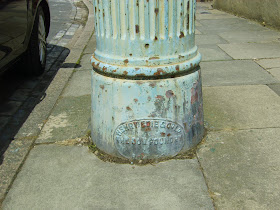Now I am pretty much sure I am going to be corrected today or at the very least attract someone who knows more about 19th century sewer ventilation pipes than I do.
But I grew up with one at the top of our road in south east London. It is still there today as is the one my brother in law took a picture of in Plumstead. Of course when you are growing up you take bits of street furniture for granted. Well I did anyway.
 Ours was tall made out of iron and was always painted a pale green although the one in Plumstead is more a pale blue. But I digress.
Ours was tall made out of iron and was always painted a pale green although the one in Plumstead is more a pale blue. But I digress.
They were for venting the sewers of the more obnoxious and even dangerous gasses which could accumulate down below. I suppose they are still necessary today.
Our Colin reckoned he heard running water when he took one picture of the base.
Now I have not come across one in Manchester but I bet there will be someone who has, and posts the fact with perhaps a picture.
I expect they help date the area. One source I read suggested that they were erected in the years after the Great London Stink in 1858 and this would fit roughly with when my bit of Peckham was being laid out. They were particularly necessary in hilly areas where gas could get trapped in pockets, and both my bit of Peckham and Colin’s Plumstead are built on hills.
And at least one chap got in on the act and in 1895. Joseph Edmund Webb, of Birmingham, patented the “Webb’s Patent Sewer Gas Destructor" in March 1895. At its top, behind a glass, burned a small flame from the town’s gas supply. This acted as a chimney, drawing the sewer gas up to the flame, where it was ignited, thus illuminating the street. The cleverness of Mr Webb’s patent was the way it regulated the supply of sewer gas.
 North Tyneside council has restored ten in Whitley Bay and Monkseaton. Blyth council has restored five.
Sheffield, though, is the capital of the destructor.
North Tyneside council has restored ten in Whitley Bay and Monkseaton. Blyth council has restored five.
Sheffield, though, is the capital of the destructor.
It was built on seven hills, so there were lots of folds and u-bends in its sewer system in which to trap gas.
From 1914 to 1935, it installed 84 destructors, of which 22 remain with three still at work, casting an orange glow on the Sheffield streets.*
And much to my surprise there is even a facebook page.
Which I think might indeed be a fitting point to close on although I have yet to find Henry Eddie & Co Ltd or the Bow Foundry.
Pictures; from the collection of Colin Fitzpatrick
*The Northern Echo July 2008 http://www.thenorthernecho.co.uk/history/memories/3211527.Is_this_just_the_tip_of_the_stink_pole_/
But I grew up with one at the top of our road in south east London. It is still there today as is the one my brother in law took a picture of in Plumstead. Of course when you are growing up you take bits of street furniture for granted. Well I did anyway.
 Ours was tall made out of iron and was always painted a pale green although the one in Plumstead is more a pale blue. But I digress.
Ours was tall made out of iron and was always painted a pale green although the one in Plumstead is more a pale blue. But I digress.They were for venting the sewers of the more obnoxious and even dangerous gasses which could accumulate down below. I suppose they are still necessary today.
Our Colin reckoned he heard running water when he took one picture of the base.
Now I have not come across one in Manchester but I bet there will be someone who has, and posts the fact with perhaps a picture.
I expect they help date the area. One source I read suggested that they were erected in the years after the Great London Stink in 1858 and this would fit roughly with when my bit of Peckham was being laid out. They were particularly necessary in hilly areas where gas could get trapped in pockets, and both my bit of Peckham and Colin’s Plumstead are built on hills.
And at least one chap got in on the act and in 1895. Joseph Edmund Webb, of Birmingham, patented the “Webb’s Patent Sewer Gas Destructor" in March 1895. At its top, behind a glass, burned a small flame from the town’s gas supply. This acted as a chimney, drawing the sewer gas up to the flame, where it was ignited, thus illuminating the street. The cleverness of Mr Webb’s patent was the way it regulated the supply of sewer gas.
 North Tyneside council has restored ten in Whitley Bay and Monkseaton. Blyth council has restored five.
Sheffield, though, is the capital of the destructor.
North Tyneside council has restored ten in Whitley Bay and Monkseaton. Blyth council has restored five.
Sheffield, though, is the capital of the destructor.It was built on seven hills, so there were lots of folds and u-bends in its sewer system in which to trap gas.
From 1914 to 1935, it installed 84 destructors, of which 22 remain with three still at work, casting an orange glow on the Sheffield streets.*
And much to my surprise there is even a facebook page.
Which I think might indeed be a fitting point to close on although I have yet to find Henry Eddie & Co Ltd or the Bow Foundry.
Pictures; from the collection of Colin Fitzpatrick
*The Northern Echo July 2008 http://www.thenorthernecho.co.uk/history/memories/3211527.Is_this_just_the_tip_of_the_stink_pole_/
No comments:
Post a Comment